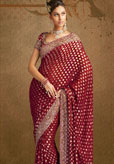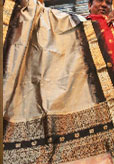
Sari has been and still is an essential part of the wardrobe of any Indian
woman. Women of India have adopted many foreign clothing. The best example
is that of
salwar kameez, which was brought
here by Mughals, many hundreds years ago. Then came Britishers who brought
with them western outfits like pants,
skirts
and shirts.
Indian woman adopted all of them. However, saree remains
the favorite attire of any Indian woman. Howsoever modern she might be, her
wardrobe remains incomplete without a collection of various
Indian sarees. Each of these sarees have to
be selected keeping in view many factors.
How to Buy Sarees?
Before going on to know some tips on buying
saree, it should be well understood that the Indian collection demands a
variety of sarees according to occasions, seasons and festivals. Therefore,
one must always try to include more than one type of saree in her wardrobe
so that she may not feel left out when going to a particular occasion.
- Buy cotton sarees
for summer season. They are light and absorb moisture well so you'll not
be bothered by heat and sweat.
- Buy silk sarees for
winters. Although some of the newer varieties of silk can be worn in
summers too but most of the traditional sarees in silk feel comfortable
in winters only.
- When it comes to monsoons, the synthetic sarees are best as they
don't cling to your body if you get wet and also get dried very fast.
Although fancy sarees of
different types are quite popular among the women but fancy synthetic
sarees are adored by them due to their lightweight, and easy
manageability.
- For special occasions, one must select from many
festival sarees
that are available in the market. Traditionally, the
banarasi sarees are
preferred for any happy occasion like engagement ceremony, house warming
party and other such gatherings.
- Georgette sarees
and chiffon sarees can
also be worn at 'not so formal' gatherings like kittie parties, birthday
celebrations etc.
- For daytime parties one need to wear a saree that give a festive feel
but do not look gaudy. Embroidered
sarees and chikan
sarees are best suited for such parties.
- Indian bride has many choices in form of a wide variety of
bridal sarees.
However, the guests too have many options. They can buy
Indian wedding
sarees created for such special occasions. They are heavily worked
with zari and other accessories.
- Office going women can opt for cotton, Georgette, or chiffon sarees
for daily purpose. For special days like those of meetings, conferences,
seminars etc. they can always buy some elegantly designed
handloom sarees.
These sarees at once give grace to ones personality.
Additional Tips for Buying Sarees
Apart from fabrics and designs,
one must also keep some other factors in mind while buying a saree.
-
 Always
ensure yourself about the optimum length of a saree. Shorter sarees can
not make enough pleats which in turn do not grant the so much
appreciated grace of a saree. The average length of a sari is 5.5 m, and
its width is approximately 1.5 m. If you are very tall, choose a saree
that is more wider. If you want to have more pleats or you will drape
the saree in a special way (like in marathi way of draping saree which
needs more wrapping around) then go for lengthier sarees. In fact, some
sarees of west India,
like the paithani sarees
are upto 8 m long.
Always
ensure yourself about the optimum length of a saree. Shorter sarees can
not make enough pleats which in turn do not grant the so much
appreciated grace of a saree. The average length of a sari is 5.5 m, and
its width is approximately 1.5 m. If you are very tall, choose a saree
that is more wider. If you want to have more pleats or you will drape
the saree in a special way (like in marathi way of draping saree which
needs more wrapping around) then go for lengthier sarees. In fact, some
sarees of west India,
like the paithani sarees
are upto 8 m long.
- If you buy a saree that contains extra cloth for making a blouse,
always ensure to measure the saree's length after deducting at least one
meter cloth from it.
- When buying embroidered sarees, see there are no broken threads in
between.
 Sari has been and still is an essential part of the wardrobe of any Indian
woman. Women of India have adopted many foreign clothing. The best example
is that of salwar kameez, which was brought
here by Mughals, many hundreds years ago. Then came Britishers who brought
with them western outfits like pants, skirts
and shirts.
Sari has been and still is an essential part of the wardrobe of any Indian
woman. Women of India have adopted many foreign clothing. The best example
is that of salwar kameez, which was brought
here by Mughals, many hundreds years ago. Then came Britishers who brought
with them western outfits like pants, skirts
and shirts.
 Always
ensure yourself about the optimum length of a saree. Shorter sarees can
not make enough pleats which in turn do not grant the so much
appreciated grace of a saree. The average length of a sari is 5.5 m, and
its width is approximately 1.5 m. If you are very tall, choose a saree
that is more wider. If you want to have more pleats or you will drape
the saree in a special way (like in marathi way of draping saree which
needs more wrapping around) then go for lengthier sarees. In fact, some
sarees of west India,
like the paithani sarees
are upto 8 m long.
Always
ensure yourself about the optimum length of a saree. Shorter sarees can
not make enough pleats which in turn do not grant the so much
appreciated grace of a saree. The average length of a sari is 5.5 m, and
its width is approximately 1.5 m. If you are very tall, choose a saree
that is more wider. If you want to have more pleats or you will drape
the saree in a special way (like in marathi way of draping saree which
needs more wrapping around) then go for lengthier sarees. In fact, some
sarees of west India,
like the paithani sarees
are upto 8 m long.